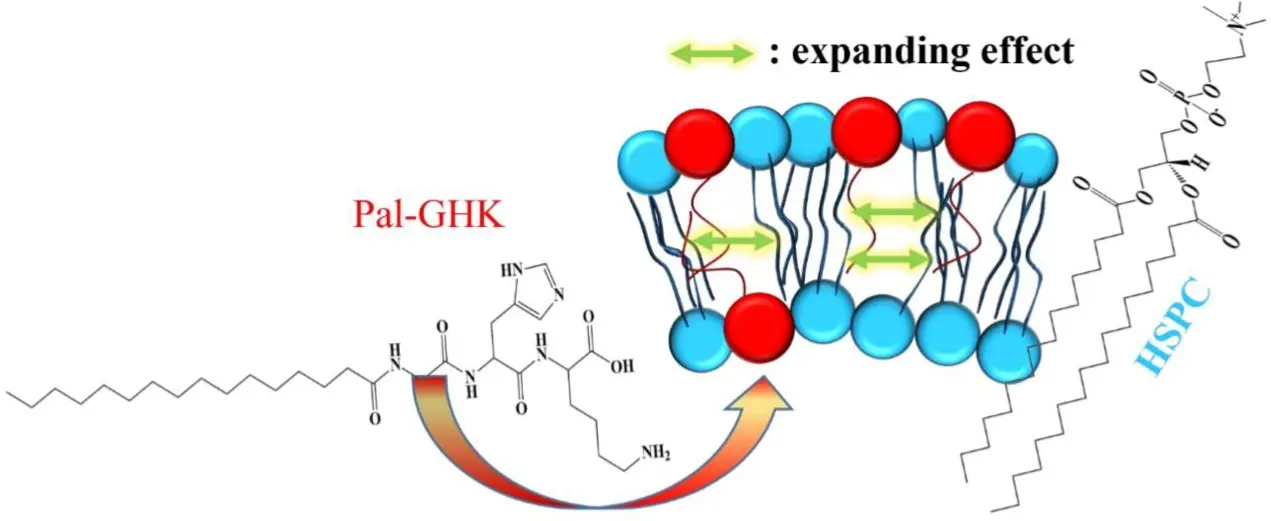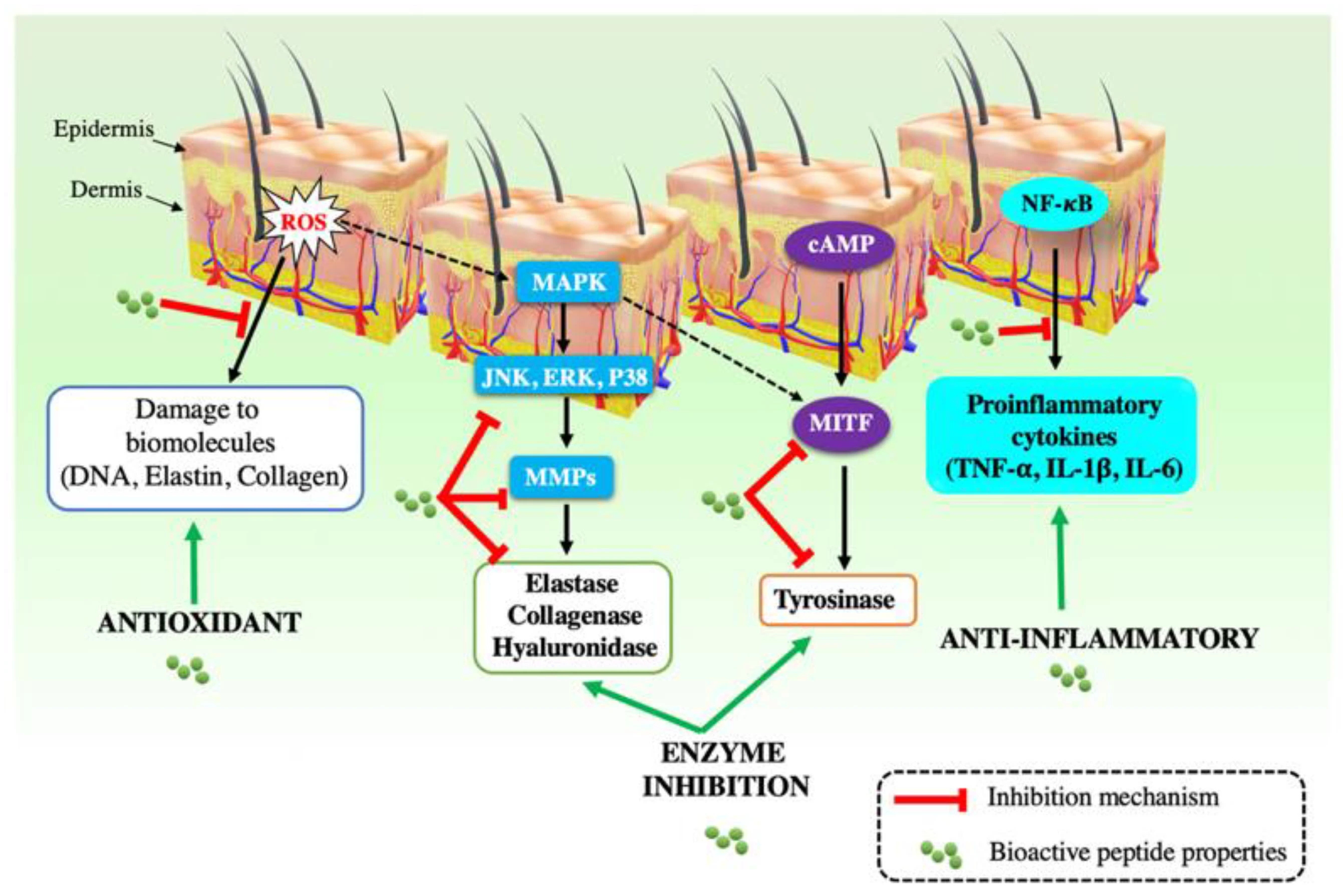Why is Palmitoyl Tripeptide-1 powder one of the ultimate answers to the skin aging problem?
Decryption from the Source: What is Palmitoyl Tripeptide-1?
To understand its value, we first need to disassemble its name.
Tripeptide-1 (tripeptide -1): This is its core structure. Peptides are short chains of amino acids linked by peptide bonds. A chain consisting of three amino acids is a tripeptide. Tripeptide-1 itself is a specific amino acid sequence (usually glycine-histidine-lysine), which simulates a key signal fragment in human extracellular matrix (such as collagen).
Palmitoyl: This is a key modifying group. The natural Tripeptide-1 molecule is hydrophilic, and it is difficult to penetrate the cutin barrier in the outermost layer of skin. A palmitoyl fatty acid chain is chemically linked to a tripeptide. This process is called "palmitoylation". This modification greatly improves the lipophilicity of the molecule, making it easier to dissolve in the formula matrix, and penetrate the skin lipid barrier to reach the dermis.
Therefore, Palmitoyl Tripeptide-1 powder is essentially a biological signal molecule after "optimized packaging". Its design logic is very ingenious: the tripeptide part is "information", and the palmitoyl chain is a "special envelope" to ensure that this "letter" can be delivered to the target address accurately.
In the world of cosmetic ingredients, the trend changes as quickly as fashion, but there are always some ingredients that stand out from the short-lived popularity and become the enduring darling of formulators and brands with their solid scientific background and remarkable effects. Palmitoyl Tripeptide-1, a name that sounds full of chemistry, is such a benchmark. Known as one of the "signal peptides", it is one of the earliest active ingredients widely studied and proved to be effective in anti-aging skin care products. However, in the face of the dazzling array of "peptides" in the market and the increasingly sophisticated biotechnology, we can't help but ask: What role does the constituent party play in today's era of rising? Is it still one of the ultimate answers to the skin aging problem? This article will discuss its scientific mechanism, industrial application, advantages, challenges and future prospects, and unveil the mystery of this classic ingredient for you.

Mechanism: How does it "command" youth at the cellular level?
Palmitoyl Tripeptide-1' s core efficacy revolves around "anti-aging" and "repair", and its mechanism is not simply "what is missing", but a higher-dimensional "signal transduction", that is, mobilizing the skin's own regeneration ability.
1. Core Mechanism: Signal Peptide Hypothesis
One of the core characteristics of skin aging is that the synthesis of extracellular matrix such as collagen and elastin in dermis decreases and the degradation increases. Fibroblasts are the factories responsible for producing these "youth proteins". With the increase of age and the damage of external environment (such as ultraviolet rays), the activity of these factories decreases and even enters a "dormant" state.
Palmitoyl Tripeptide-1 powder plays the role of "wake-up signal". When it successfully penetrates into the dermis, it will simulate the natural signal sent by the body when it starts to repair after injury, and bind to the specific receptor on the fibroblast membrane. This combination will trigger a series of complex intracellular signal transduction pathways, and finally "command" fibroblasts: accelerate the synthesis of type I, type III and type IV collagen, which is the core structural protein to maintain skin firmness and fullness.
Promote the production of elastin and fibronectin: these proteins give skin elasticity and toughness. Inhibit the activity of matrix metalloproteinases (MMPs): MMPs are "scissors" for decomposing collagen, which will be extremely active especially after ultraviolet irradiation. Palmitoyl Tripeptide-1 can effectively inhibit this "scissors", thus protecting the existing collagen from excessive degradation.
In short, its function is to "open source and reduce expenditure": it not only increases the output of new collagen, but also reduces the loss of old collagen, and combats skin relaxation and wrinkles from both sides.
2. Synergistic effect and multiple effects
In addition to its core anti-wrinkle and firming function, the research also shows that it can improve skin barrier function and indirectly enhance skin health and resistance by promoting the synthesis of extracellular matrix. Palmitoyl Tripeptide-1 powder has anti-inflammatory and repairing properties: it helps to relieve damaged skin. Enhance skin moisture content: A healthier substrate environment can better lock in moisture.
It is this multi-target, biological-based mechanism that distinguishes it from a simple humectant or sealant and becomes a truly "bioactive" component.

Industry application and quality consideration
Palmitoyl Tripeptide-1 is usually provided to formulators in the form of white to white-like fine powder in cosmetics industry. This raw material form determines a series of key considerations in product development.
1. Raw material specifications and quality control
High-end cosmetic grade Palmitoyl Tripeptide-1 powder requires high purity, stability and biological activity. The supplier will provide detailed analysis certificates, including:
Purity (HPLC): It is usually required to be higher than 95% or 98%.
Residual solvent: ensure that the organic solvent used in the production process is completely removed.
Microbial limit: it meets the hygienic standard of cosmetic raw materials.
Heavy metal content: it must be lower than the strict limit.
These indicators are the basis to ensure its safety and effectiveness.
2. Market positioning and product quality
Products containing Palmitoyl Tripeptide-1 are usually positioned as mid-to high-end anti-aging series, such as essence and cream, as the core anti-wrinkle ingredients. Eye cream: for fragile skin around eyes. The essence of ampoule: the positioning of high concentration and powerful repair.
In marketing claims, it emphasizes the effects of "remodeling collagen", "weakening deep wrinkles" and "improving skin firmness", and is often bound with keywords such as "polypeptide" and "peptide" to emphasize the composition and quality of the product.
Future prospect: enduring in the wave of innovation
Its obvious advantages are:
The research is sufficient and the evidence is solid: supported by in vitro, in vitro and clinical research data for more than 20 years, it is one of the few active peptides widely recognized by the scientific community and industry.
The mechanism of action is clear: the mechanism of signal peptide is clear, the target is clear and the logic is convincing.
Mild and efficient: Compared with classic anti-aging ingredients such as Vitamin A, Palmitoyl Tripeptide-1 powder is usually very mild and suitable for sensitive skin and long-term use.
Strong synergy: it can be perfectly matched with many other active ingredients to achieve the effect of 1+1>2. Facing the impact of cutting-edge science and technology such as synthetic biology and microbiology, where will its future go? The trend shows that it will not be out of date, but will continue its vitality in new ways.
Future anti-aging products will be more inclined to the concept of "cocktail". As a signal peptide that has stood the test of time, it will become a reliable member of the compound lineup, and cooperate with other components aimed at different pathways (such as anti-oxidation, anti-saccharification and moisturizing) to provide a comprehensive anti-aging solution.
Components of personalized skin care: A personalized skin care program based on genetic testing or skin analysis is emerging, which may be used as an accurate recommendation component for the specific sign of aging "collagen loss" and incorporated into a customized formula.
conclusion
So, is Palmitoyl Tripeptide-1 powder the ultimate answer in skin care? The answer is: it is not the only answer, but it is undoubtedly one of the cornerstones of building an effective anti-aging program, and it is an important puzzle that has been scientifically verified, reliable and indispensable.
It represents a rational and biological philosophy of skin care, which does not pursue instant magic, but leads the skin to return to a healthy and young state through gentle and continuous "dialogue" with its own repair system. For brands and formulators, it tests the real technical strength; For consumers, choosing a product containing this ingredient means choosing a scientific trust that has accumulated over time. In the noisy era of ingredient marketing, Palmitoyl Tripeptide-1 continues to silently prove its unshakable position in the industry with its solid internal and steady efficacy. It may not be the brightest star, but it is undoubtedly the eternal star that guides the direction in the night sky.
Xi'an Faithful BioTech Co., Ltd. combines cutting-edge production technology with comprehensive quality assurance to provide high-quality Palmitoyl Tripeptide-1 powder that meets international pharmaceutical standards. Our commitment to excellent, competitive prices and technical support makes us the preferred partner of global healthcare providers and researchers. Please contact our technical team in sales11@faithfulbio.com to find out how our products can improve your formula.
This is a list of the names of the core scientific research documents that I referred to and relied on in the process of writing a soft article. These documents provide solid scientific evidence for the efficacy and mechanism mentioned in this paper.
[1] Lintner, K. (2000). Peptides in Cosmetics: A Review. Cosmetics & Toiletries magazine, 115(6), 31-38.
[2] Zhang, L., & Falla, T. J. (2009). Cosmeceuticals and Peptides. In: Draelos Z.D. (eds) Cosmeceuticals. Procedures in Cosmetic Dermatology. Elsevier.
[3] Robinson, L. R., et al. (2005). Topical Palmitoyl Pentapeptide Provides Improvement in Photoaged Human Facial Skin. International Journal of Cosmetic Science, 27(3), 155-160.
[4] Lintner, K. (2007). Biologically Active Peptides: From Lab to Skin. In: Paye M., Barel A.O., Maibach H.I. (eds) Handbook of Cosmetic Science and Technology. CRC Press.
[5] Lupo, M. P., & Cole, A. L. (2007). Cosmeceutical Peptides. Dermatologic Therapy, 20(5), 343-349.
[6] Farwick, M., et al. (2011). Pentapeptide Offers Functional Improvement in Photodamaged Facial Skin. Journal of Cosmetic Dermatology, 10(2), 78-87.
[7] Sederma. (2003). Matrixyl™ 3000: Clinical and Biometrological Efficacy of a New Anti-Wrinkle Agent. Technical Dossier.
[8] (2023). International Cosmetic Ingredient Dictionary and Handbook.
[9] Barel, A. O., Paye, M., & Maibach, H. I. (Eds.). (2014). Handbook of Cosmetic Science and Technology(4th ed.). CRC Press.



